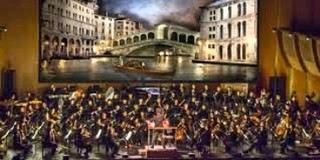|
Back
The Glory That Was Rome's New York
Avery Fisher Hall, Lincoln Center
09/16/2014 - & September 17*, 2014
“The Art of the Score: Film Week at the Philharmonic: La dolce vita: The Music of Italian Cinema:
Nino Rota: Amarcord: Theme – The Leopard: “Valzer del Commiato” (Orchestrated by F. Gurian) – Juliet of the Spirits: Suite – La dolce vita: Suite – 8 1/2: Suite
Stelvio Cipriani: The Anonymous Venetian: Suite
Ennio Morricone: Once Upon A Time in the West: “Your Love” – Incontro: “Non penso a te” – Cinema Paradiso: “Se” (with Andrea Morricone)
Luis Bacalov: City of Women: Suite – Il postino: “Mi mancherai”
Amando Trovajoli: Profumo di donna: Suite
Riz Ortolani and Nino Oliviero: Mondo Cane: Theme
Giovanni Fusco: L’Eclisse: Theme (Arranged by F. Gurian)
Nicola Piovani: Life is Beautiful: “Buongiorno Principessa”
(Unless otherwise noted, arrangements and/or orchestrations by William Ross)
Renée Fleming (Soprano), Josh Groban (Vocalist), Joshua Bell (Violin)
New York Philharmonic Orchestra, Alan Gilbert (Music Director/Conductor)
Giampiero Solari (Visual Screenplay), Giuseppe Ragazzini (Visual Artist/Set Design), William Ross (Music Consultant), Alec Baldwin (Artistic Advisor)

NY Philharmonic under The Anonymous Venetian (© HuffingtonPost)
The glories of Italian movies (forget the word cinema) started with an impossibility. As Hollywood was flooding the ruins of post-World War II Europe, the Italian Parliament ruled that for every imported American movie shown, Italy had to produce one complete movie of its own!!
And yes, they did it. With budgets originally in the hundreds of dollars, Italy made more money by renting out space for Hollywood blockbusters. And then–miracle of miracles!!–names like Fellini, Antonioni, DeSica, Loren, Mastroianni, Loren and Visconti erupted upon the world with a fury of a Rossellini Stromboli.
These were the movies which director Alan Gilbert chose to show in a very strange season opener for the New York Philharmonic. The first performance included talks from Alec Baldwin and a Rossini overture, but I chose the second performance, a bit less elitist, but–with the world’s greatest soprano and one of its greatest violinists on hand–still pretty glamorous.
Admittedly, I was highly reluctant to go. My movie-going matured with Bergman and Fellini, and I didn’t want any bits and pieces. Also, Alan Gilbert is reportedly a great fan of the “spaghetti Western” and I certainly didn’t want all those solo trumpets and galumphing galloping Morricone sounds. Third, movie music simply isn’t supposed to be heard outside of the film. That was never its purpose. And while Mr. Gilbert has (and will be) giving us 2001 and Modern Times in full, my proclivities are firmly against songs and suites.
Fortunately, the choices mostly ignored the popular Italian films, and gathered not only classic great ones (Juliet of the Spirits, The Leopard, and 8 1/2, but rarities, like City of Women, The Anonymous Venetian and the original Scent of a Woman.
One cannot doubt that Italy’s Rota and Morricone, had music to vie with France’s Auric and America’s Korngold, Tiomkin and Max Steiner. But when t this music is truncated, re-orchestrated, when placed in a suite, or as unfamiliar as the some of the movies themselves, not even Mr. Gilbert’s love and his easy-going NY Phil playing could make it into great music.
Nor did the presence of “stars” heighten this conglomeration of movies, which ran the gamut from 1959 (La dolce vita) to the overrated 1997 (Life is Beautiful). Joshua, as usual, played a gorgeous violin to make The Anonymous Venetian come alive. But the presence of Bell, Renée Fleming and Josh Groban, drawing in a full-house audience, turned the concert into an Academy Award ceremony divertimento.
Those three are Class Acts, American style, but they do nothing for Italian movies.
When I was familiar with the selections here (all the Fellini), oh, how I wanted to leap out of Avery Fisher Hall and see the complete production. I was indeed happy that this performance was being taped. Because visually (see below), this concert was a triumph.

G. Ragazzini (© Courtesy of the Artist)
What did make this evening special were the effects of two people who were barely mentioned in the program. The collaboration of Giampiero Solari and Giuseppe Ragazzini was somewhat engimatic. I don’t know what a “visual screenplay” is, but I certainly knew what Mr. Ragazzini did as the “visual artist”.
Through mapping, collages of painting and reality, through colors which burst out like 1890’s hand-painted postcards or the earliest Technicolor spectaculars, he produced graphics which–if only peripherally illustrating the movies–were stunning in themselves.
For 8 1/2, he gave a circus full of Fellini characters (including the rhinoceros from And The Ship Sailed On). For Intcontro, he produced a surrealistic set of two faces, a moon, lips, all floating over the screen. He produced the regal silk of The Leopard combined with the reality of the Burt Lancaster’s waltz. In Mondo Cane, all the incredible stars of the 1960’s–Belmondo, Cardinale, Newman, Brando, Bardot–were shown in black-and-white informal poses.
It is difficult to describe these mélanges of Art Deco, Beardsley, cartoon, gyroscope, quotations, old-fashioned inner-joke settings. But they were more fascinating than the music itself.
Perhaps, because of my love for the movies shown here (and a past incarnation as a film-reviewer in Asia), my disappointment was inevitable. Fortunately, I realized that this weekend, I could avoid the usual showings. The Film Forum Theater is playing Rossellini’s Rome, Open City, a 1945 movie that in its entirety dwarfs this week’s bits, pieces, scraps and fragments.
Harry Rolnick
|